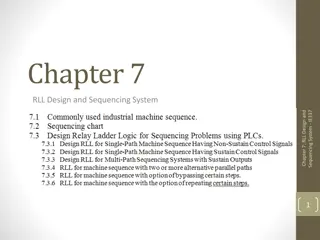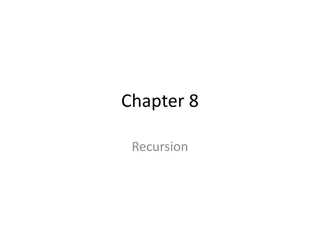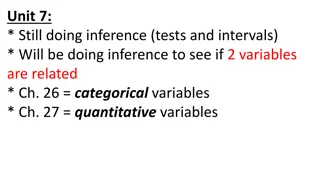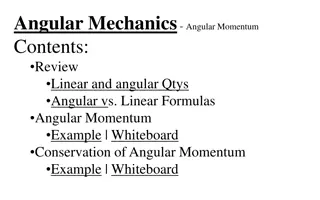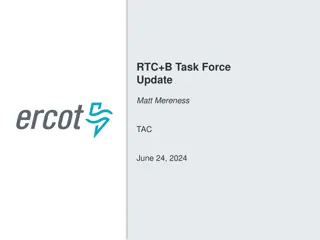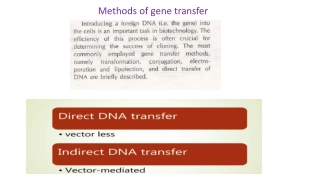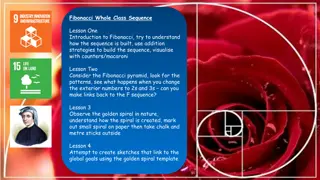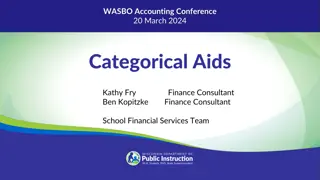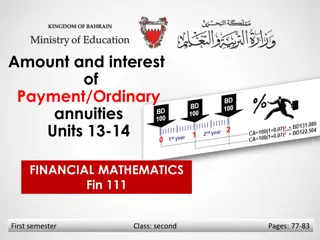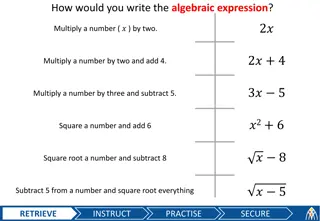Understanding Sequences and Finding Formulas
A sequence is a set of terms in a definite order, either finite or infinite, obtained by a rule. Recurrence relations help define sequences, and finding formulas involves looking for patterns like constant difference, squared or cubed numbers comparisons, and alternations of signs.
Download Presentation
Please find below an Image/Link to download the presentation.
The content on the website is provided AS IS for your information and personal use only. It may not be sold, licensed, or shared on other websites without obtaining consent from the author. Download presentation by click this link. If you encounter any issues during the download, it is possible that the publisher has removed the file from their server.
Presentation Transcript
A sequence is a set of terms, in a definite order, where the terms are obtained by some rule. A finite sequence ends after a certain number of terms. An infinite sequence is one that continues indefinitely.
For example: 1, 3, 5, 7, (This is a sequence of odd numbers) 1st term = 2 x 1 1 = 1 2nd term = 2 x 2 1 = 3 3rd term = 2 x 3 1 = 5 . . . + 2 + 2 . . . nth term = 2 x n 1 = 2n - 1
NOTATION u u u . . . 1st term = 2nd term = 3rd term = . . . 1 2 3 nth term = u n
OR u u u . . . 1st term = 2nd term = 3rd term = . . . 0 1 2 nth term = u n-1
FINDING THE FORMULA FOR THE TERMS OF A SEQUENCE
A recurrence relation defines the first term(s) in the sequence and the relation between successive terms.
For example: 5, 8, 11, 14, u u u 3 = 5 = u +3 = u +3 . . . 1 = 8 = 11 1 2 2 u n+1 = u +3 n = 3n + 2
What to look for when looking for the rule defining a sequence
Constant difference: coefficient of n is the difference 2nd level difference: compare with square numbers (n= 1, 4, 9, 16, ) 3rd level difference: compare with cube numbers (n= 1, 8, 27, 64, ) None of these helpful: look for powers of numbers (2 = 1, 2, 4, 8, ) Signs alternate: use (-1) and (-1) 2 3 n - 1 k k -1 when k is odd +1 when k is even
EXAMPLE: Find the next three terms in the sequence 5, 8, 11, 14,
EXAMPLE: 1__ 2n n The nth term of a sequence is given by x = n n a) Find the first four terms of the sequence. 1 ____ b) Which term in the sequence is ? 1024 c) Express the sequence as a recurrence relation.
EXAMPLE: Find the nth term of the sequence +1, -4, +9, -16, +25,
EXAMPLE: A sequence is defined by a recurrence relation of the form: M = aM + b. Given that M = 10, M = 20, M = 24, find the value of a and the value of b and hence find M . 4 n + 1 1 2 3
This powerpoint was kindly donated to www.worldofteaching.com http://www.worldofteaching.com is home to over a thousand powerpoints submitted by teachers. This is a completely free site and requires no registration. Please visit and I hope it will help in your teaching.




